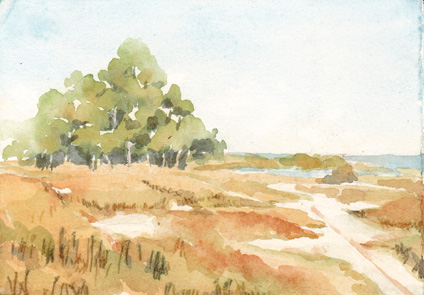I post copied two Australian landscapes paintings for "wash study" and one for fun ( *a wild weather, heavy rain, a flood in a storm last weekend!). How to interpret oil paintings into watercolour is a good challenge. It's fun to create "losing edges" vs "hard edges." Probably, softened edges and transparency in watercolour work are the most differences from medium oil. Technically, timing is crucial to put paints on wet papers.
Which landscape image do you like? I put my own favourite colours on the works.
Eucalyptus trees --
we call "gum trees," -- create beautiful scenes in a very strong sunshine. It's cool under the shade of gum trees, even it's more than 30' (*although we're in winter now). I always wonder why gum trees are peeling off trunks ... like a banana!
Study of Frederick Leist "Landscape."
Australia has very flat lands that do not have rigid mountains. Exposed red lands make a strong contrast in colours in quite a dry weather. I love white sands along the beaches and relax myself on sands.
Study of Howard Ashton "Through Sunny Meadows"
I'm getting the timing of washes for landscapes. In my view, washes are "calculated spontaneity" and a person who can control water is the winner of washes. Although there are many watercolour painting techniques and I will study them, I want to keep simple methods for myself.
Another is just for a fun. I love bright colours. A red section reminds me of strawberries. Mmm..., yum, yum! I may use this outcome for strawberries in a loose style.
Now, I'll get back to my projects.
Friends, Happy Painting!

Australian landscapes in wash study




































